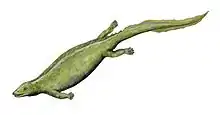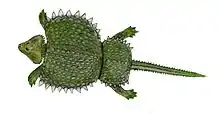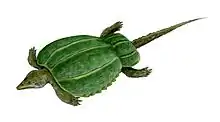楯齒龍目
楯齒龍目(Placodontia)又名盾齒龍目、齒龍目,意思為"塊狀的牙齒",是群生存於三疊紀的海生爬行動物,在三疊紀-侏儸紀滅絕事件中滅絕。一般認為牠們跟鰭龍超目有接近親緣關係,而鰭龍類也包括蛇頸龍類。楯齒龍類身長通常為1到2公尺,最大型的物種可達3公尺。牠們擁有短而非常強壯的四肢。部分原始物種在外表上類似粗厚、水桶腰的蜥蜴,而其他的物種則因為背上的大型骨板,而類似烏龜。
| 楯齒龍目 化石时期:247–200 Ma 三疊紀 | |
|---|---|
 | |
| 副楯齒龍 | |
| 科学分类 | |
| 界: | 动物界 Animalia |
| 门: | 脊索动物门 Chordata |
| 纲: | 爬行纲 Reptilia |
| 演化支: | 真爬行动物 Eureptilia |
| 演化支: | 卢默龙类 Romeriida |
| 亚纲: | 双孔亚纲 Diapsida |
| 演化支: | 新双弓类 Neodiapsida |
| 演化支: | 蜥类 Sauria |
| 下纲: | 主龙形下纲 Archosauromorpha |
| 演化支: | 泛龟类 Pantestudines |
| 总目: | †鳍龙总目 Sauropterygia |
| 演化支: | †楯齒龍形類 Placodontiformes |
| 目: | †楯齒龍目 Placodontia Cope, 1871 |
| 科 | |
| |
古生物學
最早的物種如楯齒龍,生存於三疊紀早到中期,具有略胖的身體,類似現代海鬃蜥,但體型較大。現代海鬃蜥以海藻為食,而楯齒龍類的牙齒平坦、寬廣,可能以軟體動物為食,以平坦、寬廣的牙齒壓碎軟體動物的外殼。在楯齒龍類的早期歷史,牠們可能會被鯊魚等頂級海洋掠食動物獵食。之後,楯齒龍類演化出堅硬的外殼,並面對魚龍類、幻龍類等頂級海洋掠食動物的獵食。在三疊紀晚期,無齒龍、盾龜龍演化出極為類似現代海龜的外殼,而楯齒魟則演化出不同形態的甲殼。楯齒龍類與烏龜的甲殼,是平行演化的結果。
因為牠們密集的骨頭與厚重的骨板,所以牠們不能浮在水面上,必須利用大量的能量才能抵達水面。從牠們厚重的身體與化石發現地的沉積物判斷,牠們應該存活在淺水中,而非深海。
牠們以貝類、腕足動物、以及其他無脊椎動物為食。牠們因牠們的大型、平坦、突出的牙齒為名,牠們在海床上尋找軟體動物與腕足動物(這是牠們類似海象的地方),並使用牙齒來壓碎牠們。牠們上頜極度厚大的牙齒能壓碎厚的甲殼。
參考資料
- Bardet, N. 1995. Evolution et extinction des reptiles marins au cours du Mesozoique. Palaeovertebrata 24: 177-283.
- Huene, F. von 1933. Die Placodontier. 4. Zur Lebensweise und Verwandtschaft von Placodus. Abhandlungen der Senckenbergischen Naturforschenden Gesellschaft 38: 365-382.
- Mazin, J.-M. 1986. Negevodus ramonensis n. g. n. sp., un nouveau placodonte du Trias moyen du Negev (Israel). C. R. Acad. Sci. Paris, Ser. II 302: 927-929.
- Mazin, J.-M. 1989. La denture et la région palatine des Placodontia (Reptilia, Trias). Implications phylogénétiques. Geobios 22: 725-734.
- Mazin, J.-M. and Pinna, G. 1993. Palaeoecology of the armoured placodonts. Paleontologia Lombarda, N. S. 2: 83-91.
- Nosotti, S. and Pinna, G. 1993a. Cyamodus kuhn-schnyderi n. sp., nouvelle espece de Cyamodontidae (Reptilia, Placodontia) du Muschelkalk superieur allemand. C. R. Acad. Sci. Paris, Ser. II 317: 847-850.
- Nosotti, S. and Pinna, G. 1993b. New data on placodont skull anatomy. Paleontologia Lombarda, N. S. 2: 109-114.
- Owen, R. 1858. Description of the skull and teeth of the Placodus laticeps, Owen, with indications of other new species of Placodus, and evidence of the saurian nature of that genus. Philosophical Transactions of the Royal Society of London 148: 169-184.
- Peyer, B. and Kuhn-Schnyder, E. 1955. Placodontia. IN Piveteau, J. (ed) Traite de Paleontologie, Vol. V. Masson et Cie (Paris), pp. 459–468.
- Sues, H.-D. 1987. On the skull of Placodus gigas and the relationships of the Placodontia. Journal of Vertebrate Paleontology 7: 138-144.
- Westphal, F. 1976. The dermal armour of some Triassic placodont reptiles. IN Bellairs, A. d’A. and Cox, C. B. (eds) Morphology and Biology of Reptiles. Academic Press (London).
- Zanon, R. T. 1989. Paraplacodus and the diapsid origin of Placodontia. Journal of Vertebrate Paleontology 9: 47A.
- Zanon, R. T. 1991. Negevodus ramonensis Mazin, 1986, reinterpreted as a temnospondyl, not a placodont. Journal of Vertebrate Paleontology 11: 515-518.
- Rieppel, O. 1995. The genus Placodus: systematics, morphology, paleobiogeography and paleobiology. Fieldiana (Geology), N. S. 31: 1-44.
- Rieppel, O. C. & Zanon, R. T., 1997: The interrelationships of Placodontia. Historical Biology: Vol. 12, pp. 211–227
Sues, H.-D., 1987: On the skull of Placodus gigas and the relationships of the Placodontia.
- Rieppel, O. C., 2000: Paraplacodus and the phylogeny of the Placodontia (Reptilia: Sauropterygia). Zoological Journal of the Linnean Society: Vol. 130, #4, pp. 635–659
外部連結
- http://www.oceansofkansas.com/placodnt.html
- http://users.unimi.it/vertpal/galleriafossili/best-retilli/PSEPHODERMAMORFFUNZ.html
- https://web.archive.org/web/20160222224358/http://rainbow.ldgo.columbia.edu/courses/v1001/9.html
- https://web.archive.org/web/20070714233628/http://www.palaeos.com/Vertebrates/Units/220Lepidosauromorpha/220.100.html#Placodontia
- Oceans of Kansas Palaeontology Mike Everhart
This article is issued from Wikipedia. The text is licensed under Creative Commons - Attribution - Sharealike. Additional terms may apply for the media files.


